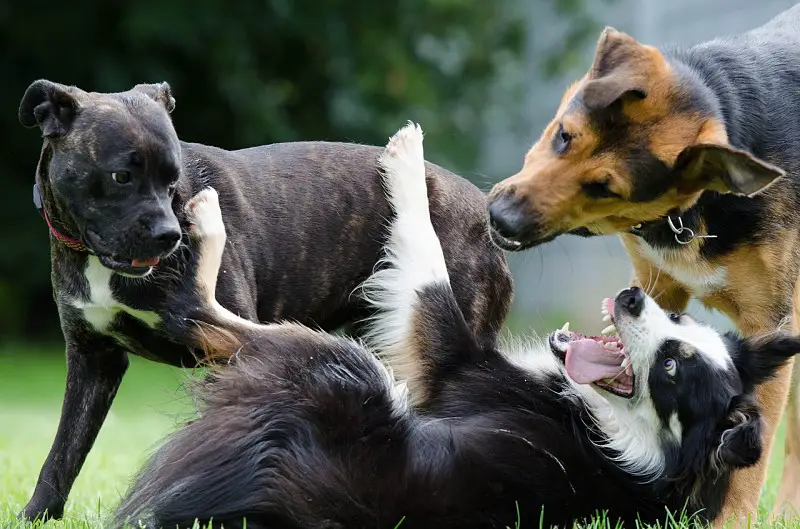The basic pattern of dog behavior is inherited from the wolf but by selective breeding humans have succeeded in reducing or exaggerating certain behavioral and physical characteristics according to the different types of dogs.
As a result we’ve created dog breeds in a range of shapes and sizes, as well as breeds with quite different personality types. Most often these personality types reflect the work for which the dog was originally designed.
So a Dachshund, originally bred for chasing small game from burrows will be more likely to dig up your garden than say, a Border Collie. But the Border Collie is more likely to have a go at “herding” your kids. Or the family cat!
National Kennel Clubs recognize the diverse personalities of dog breeds by categorizing them according to the work they were designed to do.
The forerunner of these organizations, The Kennel Club of Great Britain, was founded in 1859. It divides recognized breeds into six groups:
- Gundogs.
- Hounds.
- Terriers.
- Toy Dogs.
- Utility.
- Working.
The American Kennel Club (AKC) employs the following seven groups (plus a miscellaneous group):
- Herding.
- Hounds.
- Non-Sporting.
- Sporting.
- Terrier.
- Toy Dogs.
- Working.
Below is how I personally categorise the different types of dogs, which is a variation on these two groups.

Types of dogs
Companion dogs
As the name suggests companion dogs were bred mainly for companionship, although some of the dogs we now consider toy or companion dogs, like the Yorkie, are in fact terriers and still display terrier-like behavior.
In general they’re small, sweet and affectionate dogs, but they can be possessive and are prone to excessive barking – especially if they feel threatened.
Popular dogs in this group include:
- Bichon Frise.
- Cavalier King Charles Spaniel.
- Chihuahua.
- Maltese.
- Papillon.
- Pekingese.
- Pomeranian.
- Shih Tzu.
- Yorkshire Terrier.
Guardian dogs
Guardian dogs are usually large to giant in size, as their size was meant to intimidate intruders. Despite this they’re generally good-natured and protective, with a tendency towards laziness.
Popular dogs in this group include:
- Boxer.
- Bull Mastiff.
- Cane Corso.
- Doberman.
- Great Dane.
- Rottweiller.
- St Bernard.
Gundogs
Gundogs are good-natured, sociable, energetic, playful, intelligent, trainable and eager to please. They’re generally medium to large in size. They were bred to find and retrieve game and still have strong retrieving instincts.
Popular dogs in this group include:
- Cocker Spaniel.
- English Pointer.
- Golden Retriever.
- Irish Setter.
- Labrador Retriever.
- Portuguese Water Dog.
- Weimaraner.
Herding dogs
Herding dogs tend to be sensitive, energetic, hard-working, playful, intelligent, protective and trainable. Many are still employed as sheep and cattle herders and those that are kept as pets still have a strong herding instinct.
Popular dogs in this group include:
- Australian Shepherd.
- Border Collie.
- Rough Collie.
- German Shepherd.
- Old English Sheepdog.
- Shetland Sheepdog.
- Welsh Corgi.
Hounds
Hounds fall into two distinct groups: sight hounds and scent hounds. As the names suggest they’re hunting dogs using sight and scent respectively. They tend to be amiable, independent, and sociable, but can be stubborn. They can also be hard to control on walks, particularly if they scent or spot potential prey.
Popular dogs in this group include:
- Afghan Hound.
- Basset.
- Beagle.
- Bloodhound.
- Blue Tick Coonhound.
- Borzoi.
- Greyhound.
- Irish Wolfhound.
- Saluki.
- Whippet.
Terriers
Terriers are usually small and excitable, with strong characters. Originally bred to flush and attack small prey, they retain a predatory streak and are easily aroused to aggression. Terriers tend to be brave and confident dogs.
Popular dogs in this group include:
- Airedale.
- Border Terrier.
- Bull Terrier.
- Fox Terrier.
- Jack Russell Terrier.
- Staffordshire Bull Terrier.
- West Highland White Terrier.
Utility group
The utility group is diverse group of breeds which do not fit comfortably into any of the other groups. The individual traits depend on the work they were bred for.
Popular dogs in this group include:
- American Akita.
- Chow Chow.
- German Spitz.
- Keeshond.
- Shar Pei.
- Swedish Lapphund.
Working dogs
The working group includes breeds as diverse as the Kelpie and the Newfoundland. These dogs tend to be large, intelligent, and protective, with their temperament depending on the work they were bred for.
Popular types of dogs in this group include:
- Akita Inu.
- Alaskan Malamute.
- Kelpie.
- Newfoundland.
- Schnauzer.
- Siberian Husky.
- Samoyed.
